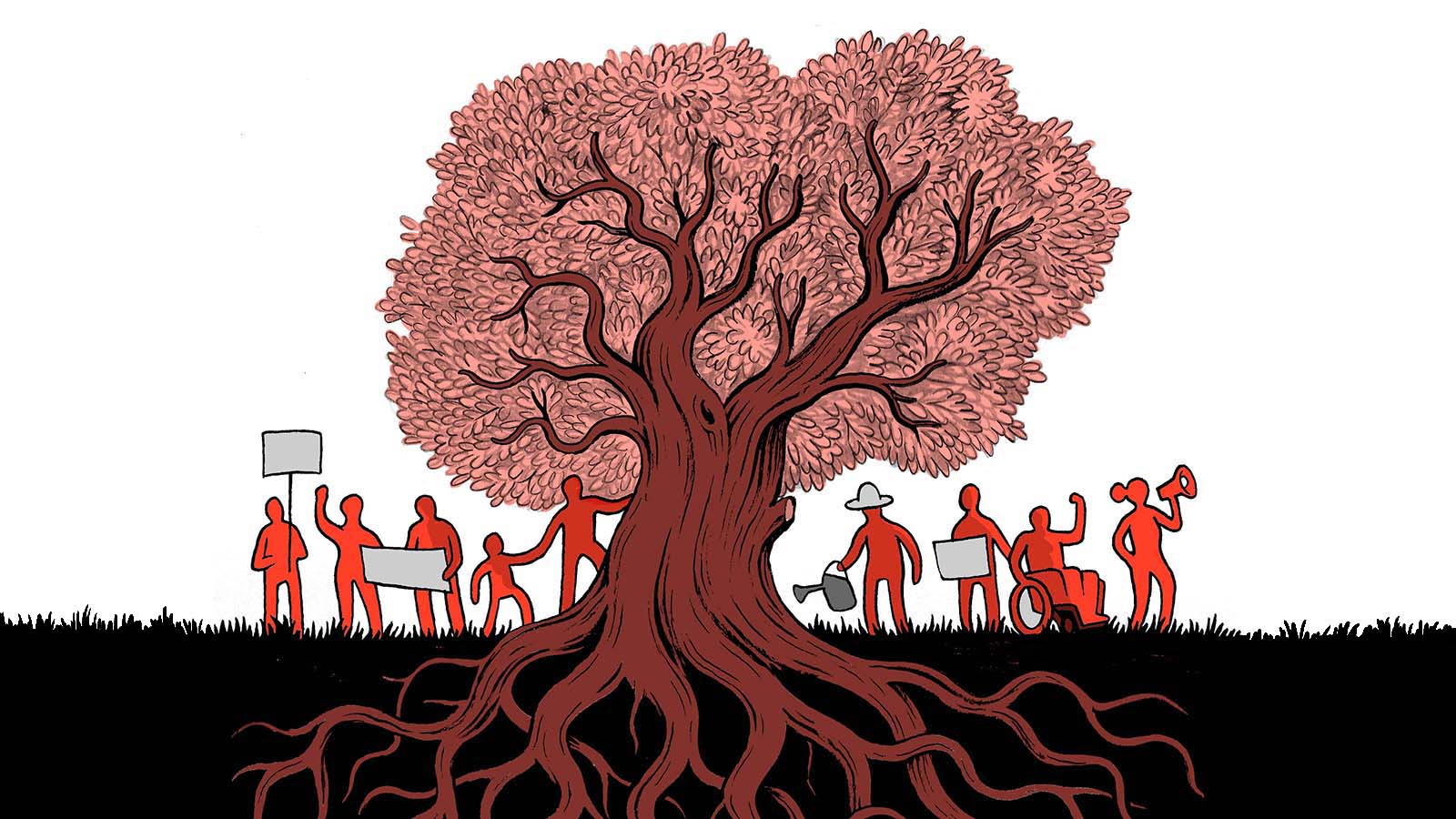Mni Wiconi, Water is Life: Review of AWAKE, A Dream from Standing Rock
By Lauren Fleer
Volume 22, number 2, Envisioning and Enacting the Science We Need
AWAKE, A Dream from Standing Rock is a poetic, evocative film documenting the Indigenous-led struggle to stop construction of the $3.8 billion Dakota Access Pipeline (DAPL). The story is presented in four parts by three different accomplished filmmakers: Josh Fox (Gasland, 2010); James Spione (Incident from New Baghdad, 2011); and director and journalist Myron Dewey from the Walker River Paiute Tribe, Agui Diccutta Band, and Temoke Shoshone in Nevada.
Floris White Bull, a member of the Standing Rock Sioux Tribe, co-wrote and narrated Part One of the film. She describes the pipeline, which threatened to pollute the drinking water source for seventeen million people, as fulfillment of a Lakota prophecy: “The black snake has been prophesied for generations. It was foretold that it would bring death and it would be the youth that would rise up, and behind them the mothers would rise, and behind them our warriors would rise. We, the seventh generation, are given the task of defeating it.” She tells of how young people initiated the movement to stop DAPL by running a 2,000 mile relay race to Washington, DC—the “headquarters of the colonial system.” This organizing work raised awareness about the pipeline and was instrumental in reunifying the seven nations of the Oceti Sakowin (dubbed the Great Sioux Nation by settlers) behind the struggle.1
Part Two features moving portraits of life in the Oceti Sakowin Camp, where as many as ten thousand people assembled to protest the pipeline and protect the Missouri River. Unnarrated footage depicts scenes of camp life where volunteers erect shelters, manage donations, move snow, charge phones via bicycle generator, sled down snowy hills, hold meetings, sing, and play music. Signatures on a tent identify participants from the Diné (Navajo) and Ojibwe Nations and the Tó’aheedlíinii Clan—visual evidence of the intertribal alliance that formed in solidarity with the water protectors at Standing Rock. These hopeful scenes alternate with brutal ones, where Morton County police attempt to clear out the camp by firing tear gas, rubber bullets, and water cannons at unarmed demonstrators in freezing temperatures.
Part Three, directed by Native American filmmaker and activist Myron Dewey, offers an explicit focus on the role of the police. He distinguishes between DAPL’s private security force and the local police, who initially demonstrated some sympathies with the Tribe. Several of the water protectors interviewed throughout the film earnestly try to connect with the human instincts of the police and military occupiers. Their faith in the human spirit is compelling, but wrenching to watch when juxtaposed with the brutality with which the police reciprocate. Prolific the Rapper, an Indigenous Hip Hop and film artist, contributes footage to the segment, including impressive landscape shots captured by drone. His song, “Black Snakes,” adds intensity to already-dramatic protest footage.
In the final segment of the film, Floris White Bull narrates the conclusion to the encampment at Standing Rock. Water protectors had celebrated the US Army Corps of Engineers’ December 2016 decision to deny the easement for drilling under the Missouri River. Weeks later, President Trump directed the Army Corps to grant the easement. In February 2017, state police and federal troops descended on the camp in a military-style takeover, slashing tipis with knives and pointing their guns inside. The film shows activists setting fire to camp structures, rather than see them defiled by authorities.2
Ultimately, Floris White Bull describes the meaning of the struggle this way: “Although our camp is gone, our spirit is not broken. It is stronger than ever. It has spread throughout the land, throughout the world, like cottonwood seeds in the wind.” Camps have since formed all over the world to fight pipelines and fracking. The film flashes a montage of protest scenes from the Diamond Pipeline in Oklahoma, the Bayou Bridge pipeline in Louisiana, and other sites in Australia, Europe, Africa, and the Amazon. “All over the world, water protectors and land defenders are rising up. We are planet protectors now, global protectors. We have awoken. We will wake up millions more. Will you wake up?”
AWAKE, A Dream from Standing Rock premiered in April 2017, as the pipeline began operating—and leaking.3 In June 2017, a federal judge ruled that by approving the DAPL easement at Lake Oahe, the Corps violated important requirements of the National Environmental Policy Act. Rather than shut down the pipeline, the judge directed the Army Corps to complete additional analysis of infringements on hunting and fishing rights, oil spill impacts, and environmental justice impacts. The Corps completed the additional study, which the Tribe still found to be inadequate.4 On this basis, the Standing Rock Sioux renewed their lawsuit against the Corps in November of 2018.5 In July of 2019, Energy Transfer Partners proposed to double the volume of oil pumped through the pipeline, from five hundred thousand to 1.1 million gallons per day, which the Tribe is also challenging.6
The fight continues at Standing Rock and elsewhere, as humankind is urgently forced to confront the rapidly intensifying global climate crisis. Many scientists stood with Standing Rock against DAPL construction, for the sake of public health, environmental justice, and biodiversity conservation.7 AWAKE goes further to expose how federal, state, and local governments use police and military force to assist private companies in their profit-making enterprises, in contravention of standing treaty obligations and with utter carelessness about the environmental risks. The confrontation at Standing Rock was a contemporary instance of a longstanding colonial project that generates trauma and destruction in its pursuit of riches. AWAKE also reminds us that we, too, are part of a generations-long project for a just and sustainable society, where humans act like they belong to the air, land, and water—not the other way around.
AWAKE, A Dream from Standing Rock
Directed by Josh Fox, James Spione, Myron Dewey
© 2017
Distributed by Bullfrog Films
References
- Nick Estes, Our History Is the Future: Standing Rock versus the Dakota Access Pipeline, and the Long Tradition of Indigenous Resistance (New York: Verso Books, 2019).
- Julia Carrie Wong, “Police Remove Last Standing Rock Protesters in Military-Style Takeover,” The Guardian, February 23, 2017.
- Sam Levin, “Dakota Access Pipeline Has First Leak before It’s Fully Operational,” The Guardian, May 10, 2017.
- “SRST NoDAPL Remand Report Final,” Standing Rock Sioux Tribe, May 1, 2019.
- “The Standing Rock Sioux Tribe’s Litigation on the Dakota Access Pipeline,” Earthjustice, last modified August 16, 2019.
- Amy R. Sisk, “Tribe, Pipeline Opponents Plan to Request State Hearing on DAPL Expansion,” Bismarck Tribune, July 10, 2019.
- “More than 220 Scientists Say Dakota Access Pipeline Threatens Biodiversity and Clean Water,” Society for Conservation Biology, accessed September 2019.





